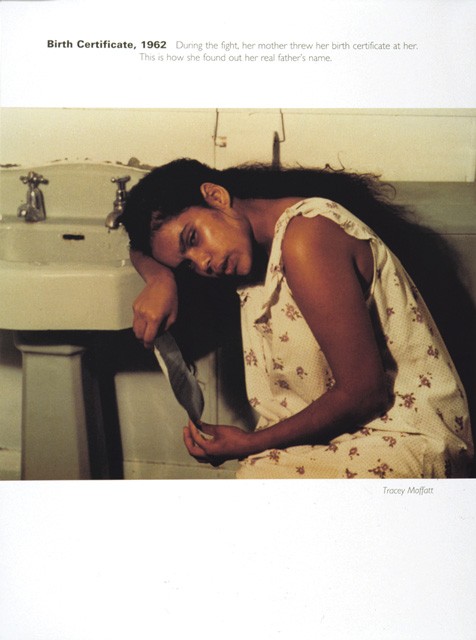


Tracey Moffatt is arguably one of Australia's most successful artists, both nationally and internationally. Since 1989, she has had over fifty solo exhibitions of her work in Europe, the USA and Australia. Moffatt's films have been screened at the Cannes Film Festival, the DIA Centre for the Arts in New York and the National Centre for Photography in Paris.
Moffatt took her first snapshots at the age of thirteen in the back garden of her parental home in Brisbane. Her work has often drawn on her background as a child growing up in the 1960s. In her youth, she avidly consumed images from magazines, films and television. The media intrigued her, a fascination that has continued to this day.
In her photographic work Moffatt tackles her subjects in ways that are analogous to film-making. She sets up clearly staged tableaux connected by narrative threads, like moments in an ongoing drama. Past and present mingle in her photography, film and video, combining such temporal elements as memory and history with the more physical subjects of violence, desire and sexuality. To this mix Moffatt brings the perspectives of her Aboriginality and femininity, but she also carefully styles her narratives to allow multiple readings beyond the specific politics of her particular Australian identity.
It was with the 1989 series Something more that Moffatt sprang to international prominence. The large, brightly coloured Cibachrome images depict the unsuccessful attempt of a beautiful woman (with Moffatt herself, with more than a hint of Hollywood melodrama, taking on the role of protagonist) to seek a better life in a large city. From the same year, the 35 mm film Night cries: a rural tragedy depicted the complex love–hate relationship between an elderly white woman and her half-Aboriginal child. The images depicted in Scarred for life (1994) are universally recognisable as snapshots of bitterly traumatic childhood memories: a girl washing a car, two kids playing, sisters who dress up to go out. Moffatt's captions make for a harrowing effect: 'Her father's nickname for her was Useless'.
The images are structured to reflect the graphic conventions of Life and similar magazines from the 1960s and early 1970s. Moffatt's use of a 'retro' style utilising filmic poses, 1960s magazine-style designs and flashbacks seems to only hammer home the harshness of her themes rather than soften them through a mist of nostalgia. Themes of conflict and force, life and death, love and sexuality run like a savage thread through Moffatt's work. They reflect the struggle on the underside of Australian society, and the strained relations between men, women and children.
'The Scarred for life series is a series of images about tragic, funny tales of childhood, all true stories told to me by friends,' Moffatt has said. 'The images are just so ordinary, and the artwork itself doesn't even look like art. It looks like pages in a magazine. It became such a smash hit. I couldn’t understand why, but I think it’s because everyone has a tragic tale to tell. Over the years people have come up to me ... they couldn't wait to tell me their tragic story.'1 Childhood and a nostalgia for the past is an ongoing theme in Australian art: a yearning for an idealised past that never occurred. Teenage years, in theory, should be full of discovery and fun, but the discoveries here are decidedly bleak.
According to Adrian Martin:
Another possible way to formulate Moffatt’s deepest, animating subject is to say that her work dramatises, in many different ways, the primal violence of socialisation—the invariably traumatic way in which each individual must be “inserted” into an ever-widening set of social, institutional frames: family, school, community, nation. This is the entry into the “symbolic” realm of psychoanalysis—the whole social fabric of preordained and sanctioned positions, identities, stereotypes, ways of behaving and appearing. And this rite of passage is, for her characters, as for each of us, never a total success—indeed, it is often a botched job … Even when the landscape or the cultural citations are unmistakably Australian, this drama of socialisation is universal.2
Scarred for life succeeds in its ability to transcend issues of racial equality or social structure, to create a harshly accurate tableau of 'normality'.
- Ashley Crawford
Tracey Moffatt is represented in Australia by Roslyn Oxley9 Gallery, Sydney.